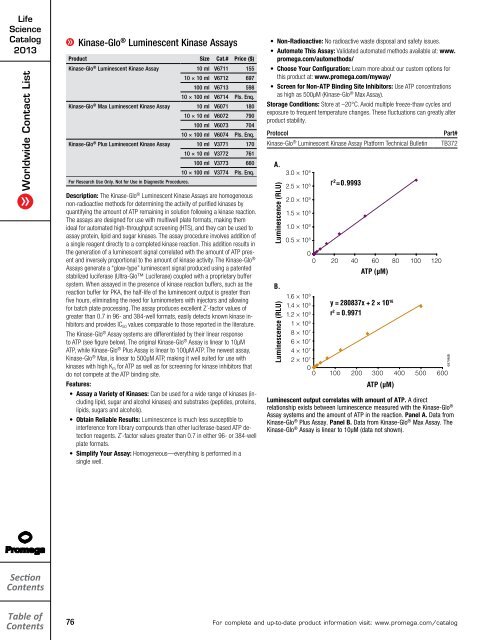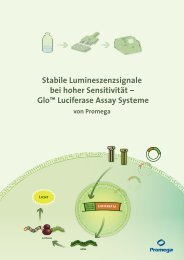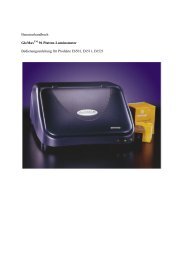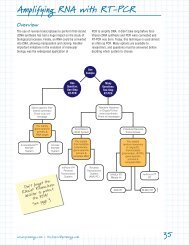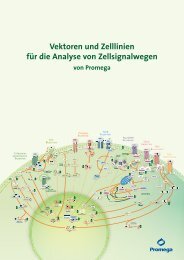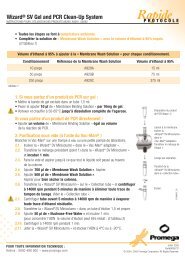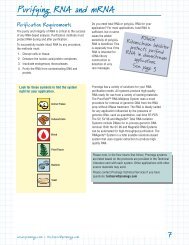2013 Promega catalogue
2013 Promega catalogue
2013 Promega catalogue
Create successful ePaper yourself
Turn your PDF publications into a flip-book with our unique Google optimized e-Paper software.
Life<br />
Science<br />
Catalog<br />
<strong>2013</strong><br />
Worldwide Contact List<br />
Cell Signaling<br />
Kinase-Glo ® Luminescent Kinase Assays<br />
Product Size Cat.# Price ($)<br />
Kinase-Glo ® Luminescent Kinase Assay 10 ml V6711 155<br />
10 × 10 ml V6712 697<br />
100 ml V6713 598<br />
10 × 100 ml V6714 Pls. Enq.<br />
Kinase-Glo ® Max Luminescent Kinase Assay 10 ml V6071 180<br />
10 × 10 ml V6072 790<br />
100 ml V6073 704<br />
10 × 100 ml V6074 Pls. Enq.<br />
Kinase-Glo ® Plus Luminescent Kinase Assay 10 ml V3771 170<br />
For Research Use Only. Not for Use in Diagnostic Procedures.<br />
10 × 10 ml V3772 761<br />
100 ml V3773 660<br />
10 × 100 ml V3774 Pls. Enq.<br />
Description: The Kinase-Glo ® Luminescent Kinase Assays are homogeneous<br />
non-radioactive methods for determining the activity of purified kinases by<br />
quantifying the amount of ATP remaining in solution following a kinase reaction.<br />
The assays are designed for use with multiwell plate formats, making them<br />
ideal for automated high-throughput screening (HTS), and they can be used to<br />
assay protein, lipid and sugar kinases. The assay procedure involves addition of<br />
a single reagent directly to a completed kinase reaction. This addition results in<br />
the generation of a luminescent signal correlated with the amount of ATP present<br />
and inversely proportional to the amount of kinase activity. The Kinase-Glo ®<br />
Assays generate a “glow-type” luminescent signal produced using a patented<br />
stabilized luciferase (Ultra-Glo Luciferase) coupled with a proprietary buffer<br />
system. When assayed in the presence of kinase reaction buffers, such as the<br />
reaction buffer for PKA, the half-life of the luminescent output is greater than<br />
five hours, eliminating the need for luminometers with injectors and allowing<br />
for batch plate processing. The assay produces excellent Z´-factor values of<br />
greater than 0.7 in 96- and 384-well formats, easily detects known kinase inhibitors<br />
and provides IC 50 values comparable to those reported in the literature.<br />
The Kinase-Glo ® Assay systems are differentiated by their linear response<br />
to ATP (see figure below). The original Kinase-Glo ® Assay is linear to 10μM<br />
ATP, while Kinase-Glo ® Plus Assay is linear to 100μM ATP. The newest assay,<br />
Kinase-Glo ® Max, is linear to 500μM ATP, making it well suited for use with<br />
kinases with high K m for ATP as well as for screening for kinase inhibitors that<br />
do not compete at the ATP binding site.<br />
Features:<br />
• Assay a Variety of Kinases: Can be used for a wide range of kinases (including<br />
lipid, sugar and alcohol kinases) and substrates (peptides, proteins,<br />
lipids, sugars and alcohols).<br />
• Obtain Reliable Results: Luminescence is much less susceptible to<br />
interference from library compounds than other luciferase-based ATP detection<br />
reagents. Z´-factor values greater than 0.7 in either 96- or 384-well<br />
plate formats.<br />
• Simplify Your Assay: Homogeneous—everything is performed in a<br />
single well.<br />
• Non-Radioactive: No radioactive waste disposal and safety issues.<br />
• Automate This Assay: Validated automated methods available at: www.<br />
promega.com/automethods/<br />
• Choose Your Configuration: Learn more about our custom options for<br />
this product at: www.promega.com/myway/<br />
• Screen for Non-ATP Binding Site Inhibitors: Use ATP concentrations<br />
as high as 500μM (Kinase-Glo ® Max Assay).<br />
Storage Conditions: Store at –20°C. Avoid multiple freeze-thaw cycles and<br />
exposure to frequent temperature changes. These fluctuations can greatly alter<br />
product stability.<br />
Protocol<br />
Kinase-Glo ® Luminescent Kinase Assay Platform Technical Bulletin<br />
A.<br />
Luminescence (RLU) Luminescence (RLU)<br />
B.<br />
20 40 60 80 100 120<br />
2.5 × 10 8 r 2 =0.9993<br />
2.0 × 10 8<br />
1.5 × 10 8<br />
1.0 × 10 8<br />
0.5 × 10 8<br />
0<br />
0<br />
3.0 × 10 8 ATP (µM)<br />
ATP (µM)<br />
Part#<br />
TB372<br />
1.6 × 10 8<br />
1.4 × 10 8 y = 280837x + 2 × 10 16<br />
1.2 × 10 8 r 2 = 0.9971<br />
1 × 10 8<br />
8 × 10 7<br />
6 × 10 7<br />
4 × 10 7<br />
2 × 10 7<br />
0<br />
0 100 200 300 400 500 600<br />
Luminescent output correlates with amount of ATP. A direct<br />
relationship exists between luminescence measured with the Kinase-Glo ®<br />
Assay systems and the amount of ATP in the reaction. Panel A. Data from<br />
Kinase-Glo ® Plus Assay. Panel B. Data from Kinase-Glo ® Max Assay. The<br />
Kinase-Glo ® Assay is linear to 10µM (data not shown).<br />
6979MB<br />
Section<br />
Contents<br />
Table of<br />
Contents<br />
76<br />
For complete and up-to-date product information visit: www.promega.com/catalog


